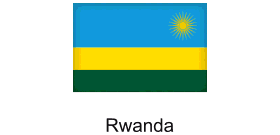 Musanze’s Conservation: How Gorilla Tourism Is Powering Rwanda’s Urban and Social Transformation
Musanze’s Conservation: How Gorilla Tourism Is Powering Rwanda’s Urban and Social Transformation
At the foot of the Virunga Massif, Musanze District has undergone a remarkable evolution over the past two decades, shifting from a tranquil agricultural landscape into a vibrant epicentre of conservation-driven development. This transformation is closely tied to the success of gorilla tourism and the annual Kwita Izina ceremony, which has become a symbol of Rwanda’s commitment to both wildlife protection and community advancement.
Since the first Kwita Izina in 2005, nearly 400 baby mountain gorillas have been named, reflecting a robust conservation strategy that has seen the local gorilla population rise from 880 in 2012 to over 1,063 today. This growth is not just a win for biodiversity; it is a testament to the power of community engagement and sustainable tourism in driving economic and social progress.
Today, Musanze is a bustling urban centre, home to more than 230,000 residents. The town’s skyline is changing, with new high-rise buildings, expanded green spaces, and a €91 million hospital upgrade underway. Infrastructure improvements stretch from the city centre to the outskirts, signalling purposeful investment and rapid progress. At the heart of this transformation is gorilla tourism, where permit fees—sometimes reaching \$1,500 per trek—generate significant revenue that fuels far-reaching development initiatives.
Through Rwanda’s innovative revenue-sharing scheme, 10% of park income is channelled directly into local projects. This has enabled the construction of schools, health centres, clean water systems, and roads, ensuring that the benefits of conservation are felt across the community. The Volcanoes Community Resilience Project (2023-2028) aims to expand the national park by 23%, boost gorilla populations by up to 20%, reduce human-wildlife conflict, and create an estimated 17,000 jobs—further cementing Musanze’s reputation as a model for conservation-led development in Africa.
But the story of Musanze is not just about numbers or infrastructure. It is a story of people—of communities whose lives have been reshaped by conservation, tourism, and new opportunities. In the heart of Musanze, cooperatives have emerged as engines of economic empowerment. Artisans, many of them women, now produce crafts and tourist items that are highly sought after by visitors. These cooperatives have not only improved household incomes but have also elevated professional skills, enabling members to create high-quality art and traditional products that fetch premium prices.
Members of these cooperatives retain 80% of their sales, with the remainder supporting cooperative administration and sustainability. The income earned has allowed families to pay school fees, improve nutrition, and invest in better housing. As Kwita Izina grows in prominence, so too does the demand for local crafts, attracting both Rwandan and international visitors and providing a steady stream of income for the community.
Infrastructure improvements have played a crucial role in supporting this growth. Roads connecting Musanze to Kinigi and surrounding areas are now well-built, facilitating smoother transport for residents and tourists alike. Health centres and schools have been established, and storage facilities such as a 100-ton potato warehouse illustrate how tourism and agriculture intersect to create tangible community benefits.
The hospitality sector in Musanze thrives during Kwita Izina, with hotels, restaurants, and bars operating at full capacity. The event draws visitors from across Africa, Europe, Asia, and America, creating a vibrant atmosphere and exposing local staff to international best practices. While tourist flows are seasonal, Kwita Izina represents a peak period that brings significant, if temporary, economic gains. Expanding the celebration and investing in infrastructure could extend visitor stays and deepen the impact, allowing more businesses to benefit from the influx of guests.
Beyond commerce, Kwita Izina fosters conservation awareness and cultural education. The Gorilla Guardian Village, founded by former poachers, offers visitors a chance to experience local culture through dance, traditional ceremonies, and hands-on activities. Revenue from the village goes directly to community members, supporting educational programmes, clean water initiatives, and insurance for conservation efforts. This approach has contributed to a measurable decline in poaching and has helped shift perceptions of wildlife from threat to opportunity.
The economic and social impact of Kwita Izina is magnified through structured revenue-sharing mechanisms. Last year, more than 35,000 people attended the ceremony, with thousands more expected in subsequent editions. The influx of visitors boosts local businesses, creates employment, and provides temporary jobs for many residents. Since the revenue-sharing programme began, the National Park has distributed \$18 million to local communities, funding projects in education, healthcare, electricity, and agriculture.
Conservation also drives employment, requiring guides, transportation, construction, and park maintenance. The presence of rangers and community vigilance groups further safeguards wildlife, reinforcing the economic value of conservation. Kwita Izina is more than a celebration; it is a platform for education, with experts from around the world sharing insights on biodiversity protection and the importance of living harmoniously with protected areas.
Tourism revenue, cooperative income, and government investment converge to improve infrastructure across Musanze. New schools, upgraded health centres, and modern housing estates are just some of the projects transforming the district. The Gorilla Guardian Village exemplifies the intersection of conservation, culture, and community services, providing access to clean water, health education, and insurance programmes. Musanze’s €91 million hospital upgrade, expanded green spaces, and new housing projects all underscore the district’s rapid progress and commitment to improved living conditions.
Despite these successes, challenges remain. Roads used by tourists still require maintenance, and issues such as poaching and illegal tree cutting persist in some areas. Seasonal fluctuations in visitor numbers create periods of high economic activity followed by quieter months, making long-term planning essential for hotels, cooperatives, and service providers. Expanding the Kwita Izina celebration and improving supply chains could help distribute economic benefits more evenly across the hospitality sector.
The outlook for Musanze is promising. The Volcanoes Community Resilience Project aims to further expand the park, increase gorilla populations, mitigate human-wildlife conflict, and generate thousands of new jobs. Combined with ongoing investments in education, health, and infrastructure, these initiatives position Musanze as a beacon of sustainable, conservation-driven development in Africa.
Kwita Izina has evolved from a conservation-focused ceremony into a catalyst for economic, social, and cultural transformation. It has empowered artisans, supported women in business, expanded hospitality and service industries, strengthened infrastructure, and provided essential public services. Most importantly, it has reshaped perceptions of wildlife, fostering pride, education, and participation in conservation efforts.
Musanze’s journey offers a blueprint for other regions in Africa and beyond. Protecting wildlife and empowering communities are not competing goals; they are complementary paths to a more prosperous, equitable future. As Musanze continues to evolve, the lessons learned here will inspire new models of sustainable development across the continent.
